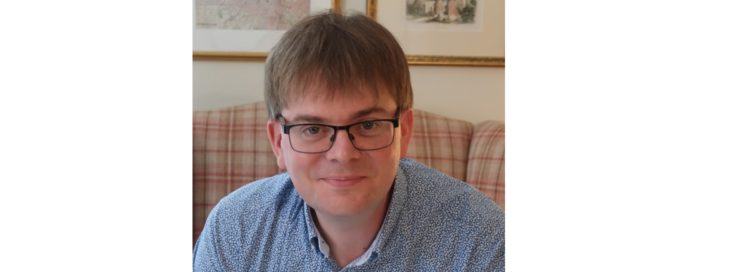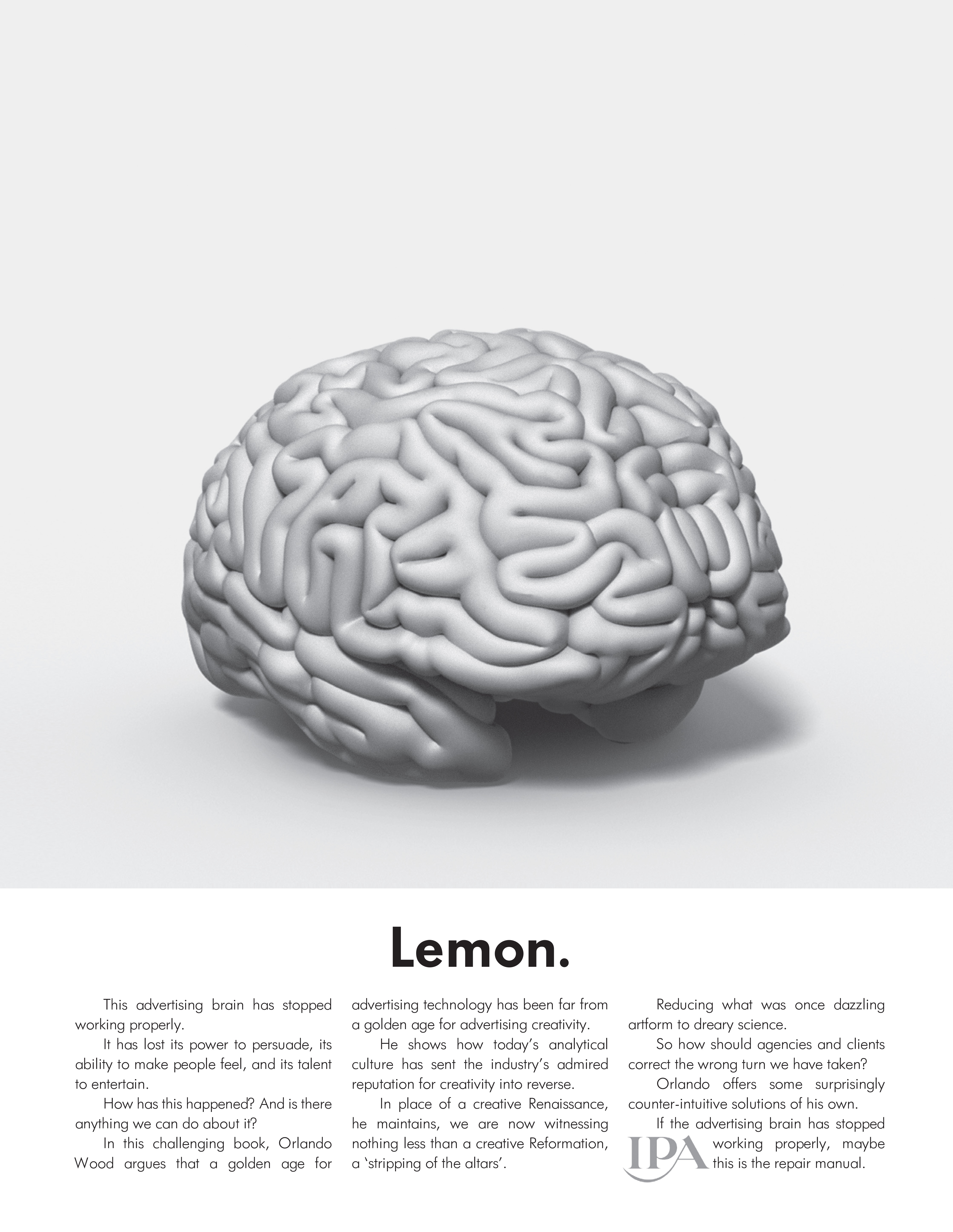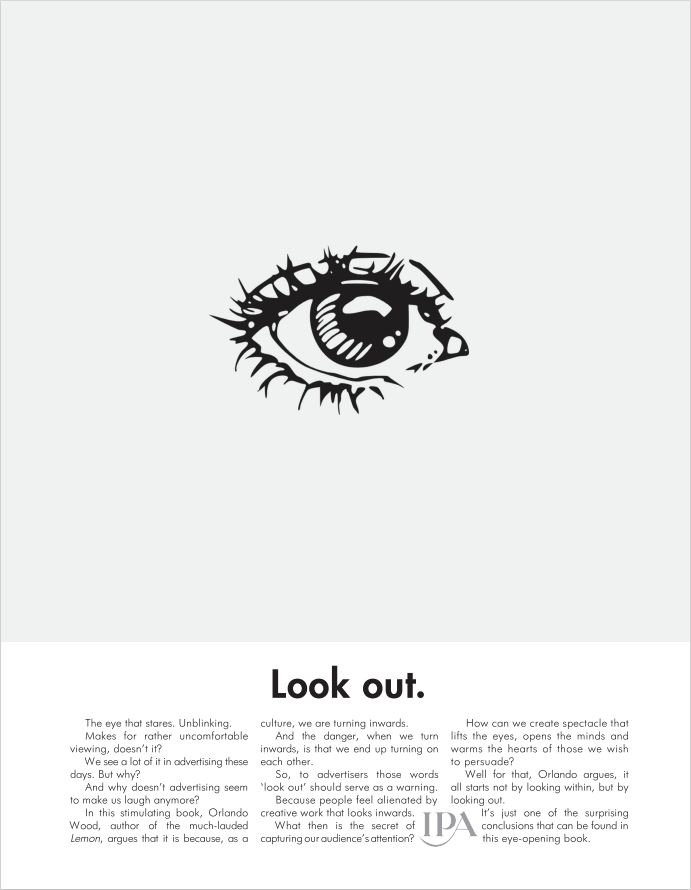If you’re finding adverts today less memorable than you used to, you’re not alone.
Orlando Wood, Chief Innovation Officer at ad effectiveness agency System 1, has been one of the most comprehensive chroniclers of what he sees as a decline in creative advertising. In two recent books, Lemon and Look Out, Orlando uses a wide range of cultural references to explain why adverts have become less effective.
Lemon took as a starting point the work of the IPA’s Peter Field, which found that campaigns were not having the kinds of lasting business effects they used to have. Studying decades of Coronation Street advert breaks, Orlando noted a marked change from 2006 onwards.
“Advertising has become quite mechanistic and devitalised,” explains Orlando. “It’s dislocated from time and space, with lots of abstraction, and less played out in lived time.”
In order to describe and explain this change, Orlando drew on the work of Iain McGilchrist, a world-leading expert in neuroscience and author. McGilchrist describes how the right brain presents a broad view of the world to us, while the left brain deploys attention more narrowly.
Orlando argues that in the digital age our attention has rapidly narrowed, and advertising has correspondingly become more oriented to this, especially that featured on sites such as Facebook and YouTube. What we are left with is left brain-focused ads – close ups of product, quick fired information, dislocated from distinctive settings.
“This narrow attention has started to create something that looks very different from the advertising of old,” he says.
It is not just for aesthetic and entertainment reasons that this is a problem. Orlando says that the newer type of advertising is “not very good at capturing attention or eliciting emotional response”.
The ads perform poorly, he says, compared with right-brain campaigns. The latter feature “something out of the ordinary”, whether it is richer landscapes, music, characters, or crucially, humour.
“Charming advertising that draws people in makes people feel as if they are part of something bigger.”
One example that Orlando draws out is an advert by Heineken from the 1980s. It features picturesque landscapes of trees and rivers as poet William Wordsworth attempts to write the famous line, “I wandered lonely as a cloud”.
The better results of right brain-focused campaigns are evident in IPA effectiveness data, Orlando says, establishing greater trust and esteem, and raising the fame or salience of the brand.
As physical locations close down and companies move online, far from being obsolete, Orlando argues, this type of advertising is more important than ever.
“Characters should be the mainstay of advertising”
The year he establishes as the turning point, 2006, is the year before the beginnings of the financial crisis and the launch of the iPhone. A number of trends coincided around that time, he says, noting the shift to digital and consolidation in the advertising world. There were new production methods, a shift to global advertising and a move in habits of thinking towards more linear, transactional mindsets.
Part of the change has been in the digital format, as opposed to the old world of television where people could be expected to sit through an ad break. As Orlando notes, advertisers using the five seconds before a YouTube video starts don’t have long to make an impression. The metrics used to measure marketing effectiveness in the digital world have also been geared towards short-term feedback, which further optimises for these types of ads.
He argues that the type of advert that people will continue watching after five seconds are more likely to be those that draw on the right brain themes of character, incident and place.
The use of characters which form the creative centre of multiple ads, called fluent devices, has been in decline recently. This is despite characters such as the Compare The Market meerkats being “a very effective way of reducing price sensitivity and offering big market share gains compared to other types of campaign.”
“In those early seconds they tell you what the brand is and tell you in a way that’s living and intriguing. Characters should absolutely be the mainstay of advertising, particular audiovisual advertising.”
He contrasts the use of characters to the use of brand assets such as shapes, fonts, colours and logos, which don’t offer the same dynamism.
“Consistency can be the enemy of movement. What you need is living characters, people doing things.”
Orlando also highlights the limiting role that focus groups and workshops can play on creativity.
“You can kill an idea very easily or water it down to an extent it’s not longer an idea.”
There has been an increasing risk averseness, he adds. Orlando argues this is not warranted considering that while bolder ideas may feel risky, the tools for testing ideas are better than ever. Companies can “look before they leap,” explains Orlando, quoting David Ogilvy.
System 1, for example, is able to test the emotional response to an advert. One client noted that this testing had allowed them to be “brave, without being stupidly brave.”
“With all the evidence we’re compiling, we’re much better able to articulate now what it is that holds attention,” he says.
Metrics that capture emotion
Part of the problem may be that advertisers are using the wrong metrics. More of a focus is needed on emotional measurement as well as attention. Orlando also argues that a narrow focus on ROI from marketing can lead to the wrong priorities.
“One way to increase ROI is to spend less. But what makes marketing efficient is not what makes it effective. You do need a certain amount of spend behind your brand; you can be very efficient without growing anything at all.”
He says that campaigns that achieve long-term effects and market share gains tend to have poor ROI.
“As Les Binet said, the most efficient company is one that doesn’t exist.”
Orlando believes there is a strong appetite to do this type of more creative work and hopes that the tide may shift back.
“Talking to CMOs, many of them I spoke to feel frustrated that they’re not able to get the brand building work anymore.
“The public is desperate for it. We want things that are going to make us smile, laugh and connect with each other again.”
He fears that the general direction may be towards solemnity and a lack of humour.
For the financial services sector, Orlando says that there is often very little to differentiate between different products. To be front of mind, emotional approaches are the most effective.
“You do need to think about how to create salience rather than simply plugging information about it that may go totally over the heads of most people.”
An example used in the book is the Crocker Bank’s 70s advert. In an effort to rebalance the bank’s aging customer base, American advertising executive Hal Riney decided to commission a song.
This was “We’ve Only Just Begun”, written by Bugsy Malone songwriter Paul Williams and later covered by the Carpenters. The advert features pictures of a couple getting married, getting in a car and going on their honeymoon.
“There are precedents in history for banks, financial comparison sites, insurance [companies], that do this and create a salience for themselves so they are top of the mental shopping list.”
It may feel risky, Orlando says, but companies have to “bite the bullet”.
“If you feel a slight nervousness and excitement at what it is you’ve got, you might be onto something.”
Marketers as generalists
What really leaps out from talking to Orlando or looking at his books is the wide range of references he draws on. In the books he draws on art history, philosophy and music.
He argues that marketers can benefit from learning about as broad a range of disciplines and areas as possible.
“There’s a great case to be made for generalists; people who draw on multiple disciplines to synthesise them to create something new.
“You have to triangulate between things otherwise you end up in a narrow furrow, and that’s one of the curses of our age. Specialisation is great for efficiency.”
He says that it’s crucial to “follow your passions”.
“You can’t bore people into buying your product. People read what interests them and sometimes it’s an ad.
“The best ads tend to reference culture: what’s going on and what’s gone on before.”
The brands that will cut through will be the ones who then go on to insert themselves into the culture.



